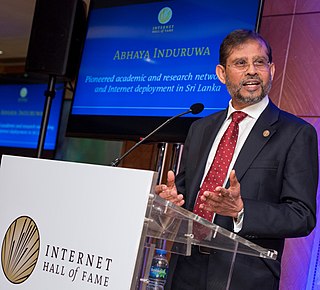
The Defense Advanced Research Projects Agency (DARPA) is a research and development agency of the United States Department of Defense responsible for the development of emerging technologies for use by the military.

James Sacra Albus was an American engineer, Senior NIST Fellow and founder and former chief of the Intelligent Systems Division of the Manufacturing Engineering Laboratory at the National Institute of Standards and Technology (NIST).
A virtual enterprise (VE) is a temporary alliance of businesses that come together to share skills or core competencies and resources in order to better respond to business opportunities, and whose cooperation is supported by computer networks.

The U.S. Army Combat Capabilities Development Command Army Research Laboratory is the U.S. Army's foundational research laboratory. ARL is headquartered at the Adelphi Laboratory Center (ALC) in Adelphi, Maryland. Its largest single site is at Aberdeen Proving Ground, Maryland. Other major ARL locations include Research Triangle Park, North Carolina, White Sands Missile Range, New Mexico, Graces Quarters, Maryland, and NASA's Glenn Research Center, Ohio and Langley Research Center, Virginia. ARL also has regional sites in Playa Vista, California, Chicago, Austin, TX, and Boston.
Internet of things (IoT) describes devices with sensors, processing ability, software and other technologies that connect and exchange data with other devices and systems over the Internet or other communication networks. The Internet of things encompasses electronics, communication, and computer science engineering. "Internet of things" has been considered a misnomer because devices do not need to be connected to the public internet; they only need to be connected to a network and be individually addressable.

The United Kingdom has been involved with the Internet throughout its origins and development. The telecommunications infrastructure in the United Kingdom provides Internet access to homes and businesses mainly through fibre, cable, mobile and fixed wireless networks, with the UK's 140-year-old copper network, maintained by Openreach, set to be withdrawn by December 2025, although this has since been extended to 31st January 2027 in some areas due to reasons including panic alarms in sheltered housing needing a persistent connection which can't be guaranteed with internet-based DECT systems.

BT Research is the research arm of BT Group, formerly part of the British Post Office. The company was first established in 1921 as the Post Office Research Station at Dollis Hill, London. In 1968 BT moved of its research to the new site at Martlesham Heath based on part of the old Royal Air Force Station at Martlesham Heath near Ipswich in the English county of Suffolk, which was later renamed Adastral Park.
The Network Science Collaborative Technology Alliance (NS CTA) is a collaborative research alliance funded by the US Army Research Laboratory (ARL) and focused on fundamental research on the critical scientific and technical challenges that emerge from the close interdependence of several genres of networks such as social/cognitive, information, and communications networks. The primary goal of the NS CTA is to deeply understand the underlying commonalities among these intertwined networks, and, by understanding, improve our ability to analyze, predict, design, and influence complex systems interweaving many kinds of networks.

Dana Ulery is an American computer scientist and pioneer in scientific computing applications.

Abhaya Induruwa is the inaugural Professor V K Samaranayake Endowed Professor of Computing, University of Colombo School of Computing, Sri Lanka. Having served as the Director of Cyber Innovation Hub he recently retired from the Canterbury Christ Church University in the United Kingdom where he researched into security and forensic investigation of Internet of Things (IoT). Currently he is engaged in promoting IoT in digital agriculture as a disruptive technology, primarily in developing countries, leading to smart agriculture resulting in higher yields in food production. Induruwa is considered the father of Internet in Sri Lanka.
In robot combat, a self-righting mechanism or srimech is a device used to re-right a robot should it get flipped. Biohazard of BattleBots was the first robot to self-right.
Information Operations is a category of direct and indirect support operations for the United States Military. By definition in Joint Publication 3-13, "IO are described as the integrated employment of electronic warfare (EW), computer network operations (CNO), psychological operations (PSYOP), military deception (MILDEC), and operations security (OPSEC), in concert with specified supporting and related capabilities, to Information Operations (IO) are actions taken to affect adversary information and information systems while defending one's own information and information systems.

Bruce Edward Hajek is a Professor in the Coordinated Science Laboratory, the head of the Department of Electrical and Computer Engineering, and the Leonard C. and Mary Lou Hoeft Chair in Engineering at the University of Illinois Urbana–Champaign. He does research in communication networking, auction theory, stochastic analysis, combinatorial optimization, machine learning, information theory, and bioinformatics.
The International Technology Alliance in Network and Information Sciences (NIS-ITA) was a research program initiated by the UK Ministry of Defence (MoD) and the US Army Research Laboratory (ARL), which was active for 10 years from May 2006 to May 2016. It was led by IBM Research in the U.S. and IBM Hursley in the UK. NIS ITA was the first International Technology Alliance started by the two countries.
The International Technology Alliance in Distributed Analytics and Information Sciences (DAIS-ITA) was a research program initiated by the UK Ministry of Defence (MOD) and the US Army Research Laboratory (ARL), in September 2016 and remained active for 5 years until September 2021. It was led by IBM Research in the U.S. and IBM Hursley in the UK. DAIS ITA is the second International Technology Alliance started by the two countries, succeeding the previous ten year alliance NIS-ITA, which was of similar nature.

The United States Army Futures Command (AFC) is a United States Army command that runs modernization projects. It is headquartered in Austin, Texas.
Cyber Security Collaborative Research Alliance (CSCRA) was a research program initiated and sponsored by the US Army Research Laboratory (ARL). The objective of the program was "to develop a fundamental understanding of cyber phenomena, including aspects of human attackers, cyber defenders, and end users, so that fundamental laws, theories, and theoretically grounded and empirically validated models can be applied to a broad range of Army domains, applications, and environments."
Multi-Scale Multidisciplinary Modeling of Electronic Materials (MSME) Collaborative Research Alliance (CRA) was a research program in the United States that was initiated and sponsored by the US Army Research Laboratory (ARL). The objective of the program was “to develop quantitative understanding of materials from the smallest to the largest relevant scales to advance the state of the art in electronic, optoelectronic and electrochemical materials and devices.”
The Internet of Military Things (IoMT) is a class of Internet of things for combat operations and warfare. It is a complex network of interconnected entities, or "things", in the military domain that continually communicate with each other to coordinate, learn, and interact with the physical environment to accomplish a broad range of activities in a more efficient and informed manner. The concept of IoMT is largely driven by the idea that future military battles will be dominated by machine intelligence and cyber warfare and will likely take place in urban environments. By creating a miniature ecosystem of smart technology capable of distilling sensory information and autonomously governing multiple tasks at once, the IoMT is conceptually designed to offload much of the physical and mental burden that warfighters encounter in a combat setting.
The Atmospheric Sciences Laboratory (ASL) was a research institution under the U.S. Army Materiel Command that specialized in artillery meteorology, electro-optical climatology, atmospheric optics data, and atmospheric characterization from 1965 to 1992. ASL was one of the seven Army laboratories that merged to form the U.S. Army Research Laboratory (ARL) in 1992.









